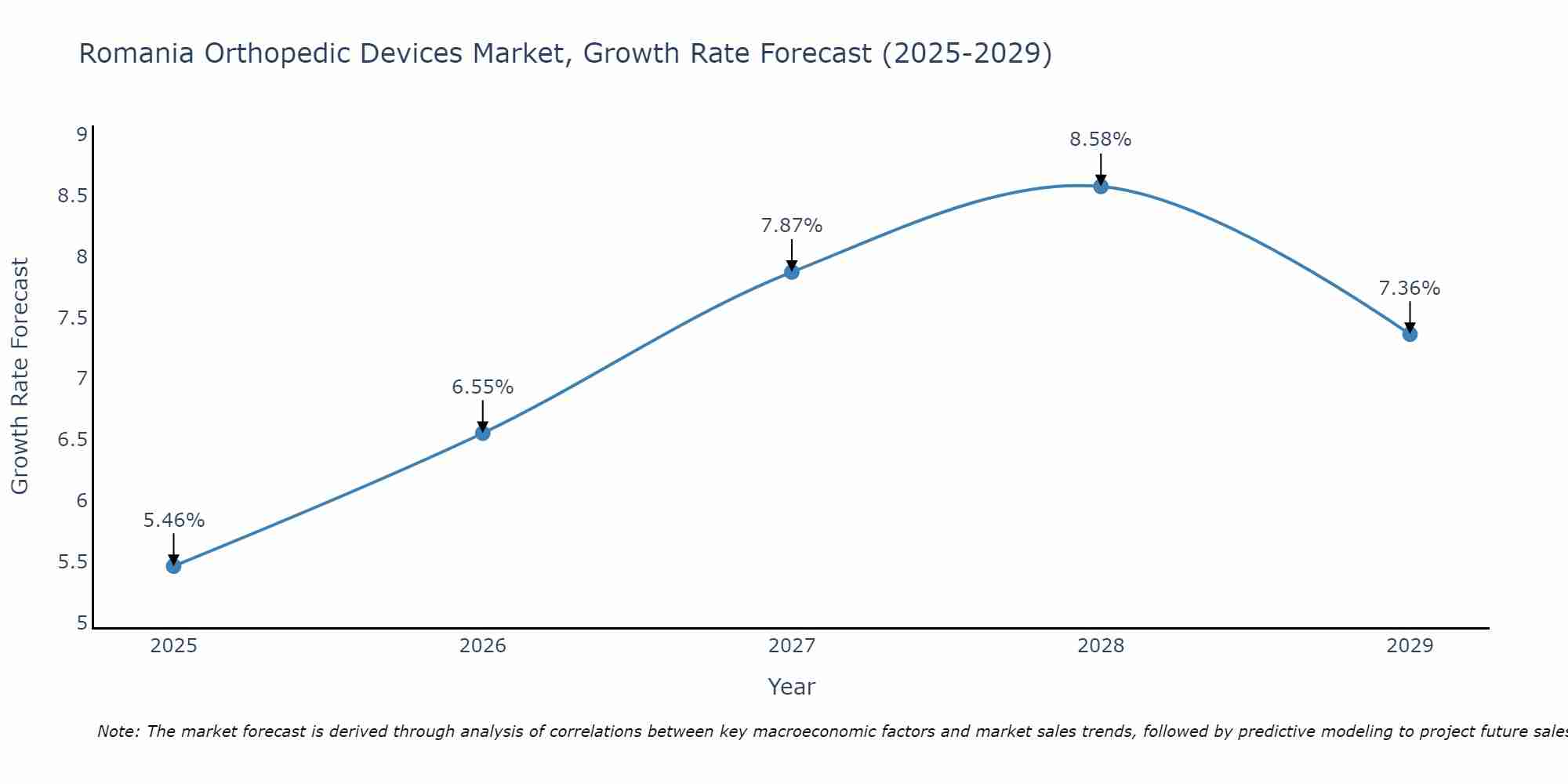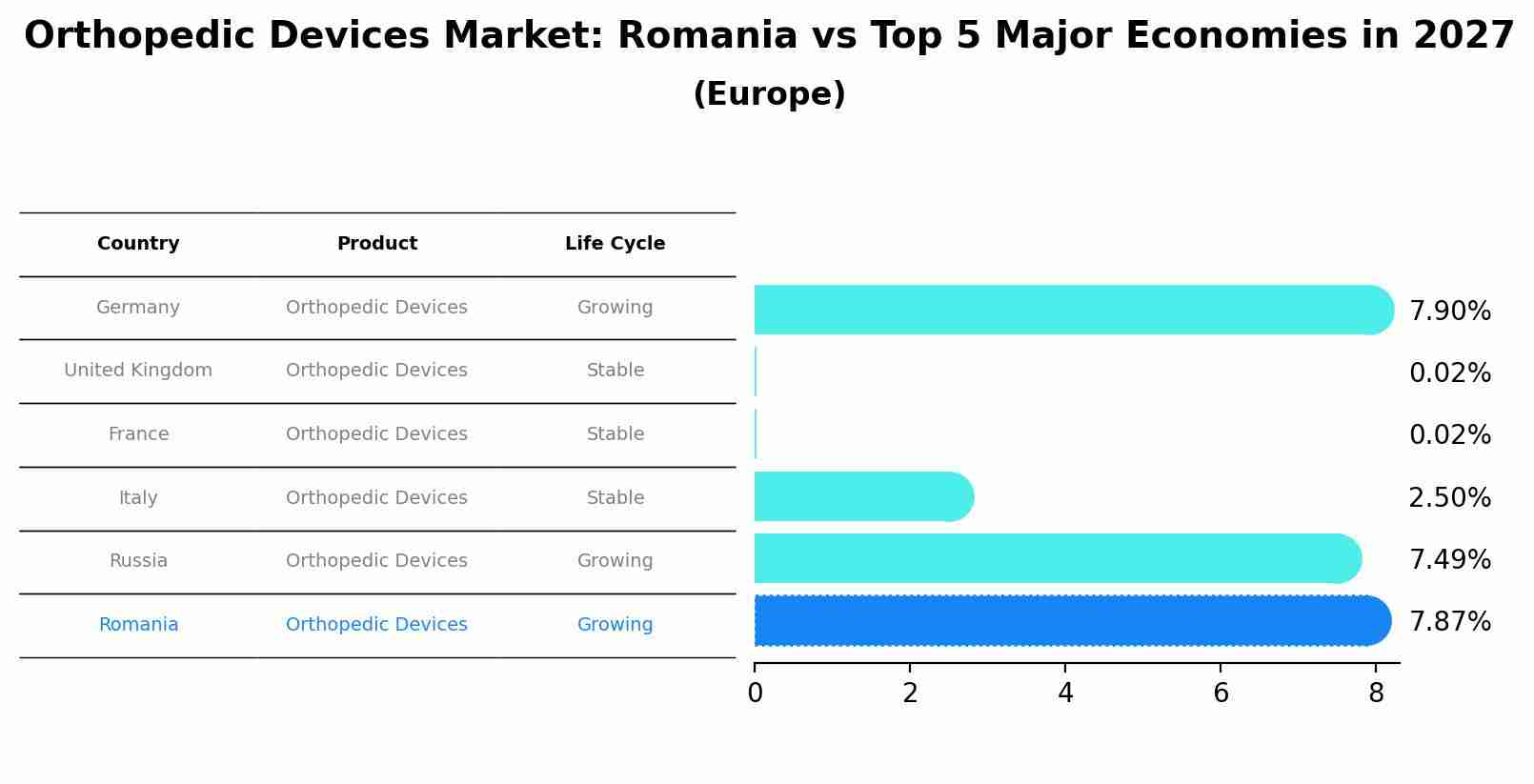Romania Orthopedic Devices Market Outlook | Companies, Share, Revenue, Growth, Forecast, Value, Trends, Analysis, COVID-19 IMPACT, Industry & Size
| Product Code: ETC368118 | Publication Date: Aug 2022 | Updated Date: Jul 2025 | Product Type: Market Research Report | |
| Publisher: 6Wresearch | Author: Summon Dutta | No. of Pages: 75 | No. of Figures: 35 | No. of Tables: 20 |
Romania Orthopedic Devices Market Size Growth Rate
The Romania Orthopedic Devices Market is projected to witness mixed growth rate patterns during 2025 to 2029. The growth rate begins at 5.46% in 2025, climbs to a high of 8.58% in 2028, and moderates to 7.36% by 2029.

Orthopedic Devices Market: Romania vs Top 5 Major Economies in 2027 (Europe)
Romania's Orthopedic Devices market is anticipated to experience a growing growth rate of 7.87% by 2027, reflecting trends observed in the largest economy Germany, followed by United Kingdom, France, Italy and Russia.

Romania Orthopedic Devices Market Synopsis
The Romania Orthopedic Devices Market is experiencing steady growth driven by factors such as increasing prevalence of orthopedic disorders, rising geriatric population, and advancements in medical technology. The market encompasses a wide range of products including orthopedic implants, prosthetics, braces, and support devices. Key players in the market are focusing on innovation and product development to meet the growing demand for minimally invasive procedures and personalized orthopedic solutions. Government initiatives to improve healthcare infrastructure and access to orthopedic care are also contributing to market growth. However, challenges such as pricing pressures, regulatory hurdles, and reimbursement issues are impacting market dynamics. Overall, the Romania Orthopedic Devices Market presents opportunities for companies to expand their product offerings and tap into a growing patient population in need of orthopedic interventions.
Romania Orthopedic Devices Market Trends
The Romania Orthopedic Devices Market is experiencing several key trends. One significant trend is the increasing adoption of minimally invasive procedures, such as arthroscopic surgeries and robotic-assisted surgeries, which offer patients shorter recovery times and less post-operative pain. Another trend is the rising prevalence of orthopedic conditions among the aging population, driving the demand for joint replacement surgeries and orthopedic implants. Additionally, there is a growing focus on the development of advanced materials and technologies in orthopedic devices, such as 3D printing and bioresorbable implants, to improve patient outcomes and enhance the overall quality of care. Overall, these trends are shaping the Romania Orthopedic Devices Market towards more innovative and patient-centric solutions.
Romania Orthopedic Devices Market Challenges
The Romania Orthopedic Devices Market faces several challenges, including limited access to advanced technologies and high-quality products due to budget constraints in the healthcare system. Additionally, there is a shortage of trained professionals and specialists in the field of orthopedics, leading to delays in diagnosis and treatment. The market also experiences competition from neighboring countries with more developed healthcare infrastructure, which can hinder local manufacturers` growth and market penetration. Regulatory hurdles and reimbursement issues further complicate the market landscape, making it challenging for companies to introduce new devices and technologies. Overall, these challenges create barriers to innovation, market expansion, and optimal patient care within the Romania Orthopedic Devices Market.
Romania Orthopedic Devices Market Investment Opportunities
The Romania orthopedic devices market presents several investment opportunities due to the increasing demand for orthopedic surgeries and treatments, driven by the aging population and the rising prevalence of musculoskeletal disorders. Key areas for investment include innovative technologies such as 3D printing for customized implants, robotic-assisted surgeries, and minimally invasive procedures. Additionally, there is potential for growth in the development of advanced materials and biologics for orthopedic devices, as well as the expansion of distribution networks to reach a wider customer base in Romania and potentially other European markets. Investing in research and development to improve product efficiency and patient outcomes, as well as strategic partnerships with local healthcare providers, could also position investors for success in the Romania orthopedic devices market.
Jordan Agar Market Government Policies
In Romania, government policies related to the orthopedic devices market are primarily regulated by the National Health Insurance House (CNAS) and the Ministry of Health. The CNAS establishes reimbursement policies for orthopedic devices, ensuring affordability and access for patients. Additionally, the Ministry of Health oversees the registration and approval process for orthopedic devices to ensure safety, efficacy, and quality standards are met. These regulations aim to promote transparency, protect public health, and maintain a competitive market for orthopedic devices in Romania. Companies operating in the orthopedic devices market must comply with these governmental policies to commercialize their products and provide healthcare professionals with innovative solutions for patient care.
Romania Orthopedic Devices Market Future Outlook
The Romania Orthopedic Devices Market is expected to witness steady growth in the coming years due to factors such as an aging population, increasing prevalence of musculoskeletal disorders, and advancements in orthopedic technology. The market is likely to benefit from the rising demand for minimally invasive procedures, innovative implant materials, and personalized orthopedic solutions. Additionally, an emphasis on improving healthcare infrastructure and increasing healthcare expenditure in Romania will further drive market growth. However, challenges such as regulatory hurdles, pricing pressures, and competition from alternative therapies may impact market expansion. Overall, with a growing patient population in need of orthopedic interventions and ongoing technological advancements, the Romania Orthopedic Devices Market is poised for promising opportunities in the foreseeable future.
Key Highlights of the Report:
- Romania Orthopedic Devices Market Outlook
- Market Size of Romania Orthopedic Devices Market, 2021
- Forecast of Romania Orthopedic Devices Market, 2031
- Historical Data and Forecast of Romania Orthopedic Devices Revenues & Volume for the Period 2018 - 2031
- Romania Orthopedic Devices Market Trend Evolution
- Romania Orthopedic Devices Market Drivers and Challenges
- Romania Orthopedic Devices Price Trends
- Romania Orthopedic Devices Porter's Five Forces
- Romania Orthopedic Devices Industry Life Cycle
- Historical Data and Forecast of Romania Orthopedic Devices Market Revenues & Volume By Application for the Period 2018 - 2031
- Historical Data and Forecast of Romania Orthopedic Devices Market Revenues & Volume By Hip Orthopedic Devices for the Period 2018 - 2031
- Historical Data and Forecast of Romania Orthopedic Devices Market Revenues & Volume By Knee Orthopedic Devices for the Period 2018 - 2031
- Historical Data and Forecast of Romania Orthopedic Devices Market Revenues & Volume By Spine Orthopedic Devices for the Period 2018 - 2031
- Historical Data and Forecast of Romania Orthopedic Devices Market Revenues & Volume By Craniomaxillofacial Orthopedic Devices for the Period 2018 - 2031
- Historical Data and Forecast of Romania Orthopedic Devices Market Revenues & Volume By Dental Orthopedic Devices for the Period 2018 - 2031
- Historical Data and Forecast of Romania Orthopedic Devices Market Revenues & Volume By Sports Injuries, Extremities And Trauma (Set) Orthopedic Devices for the Period 2018 - 2031
- Historical Data and Forecast of Romania Orthopedic Devices Market Revenues & Volume By Product for the Period 2018 - 2031
- Historical Data and Forecast of Romania Orthopedic Devices Market Revenues & Volume By Drill Guide for the Period 2018 - 2031
- Historical Data and Forecast of Romania Orthopedic Devices Market Revenues & Volume By Guide Tubes for the Period 2018 - 2031
- Historical Data and Forecast of Romania Orthopedic Devices Market Revenues & Volume By Implant Holder for the Period 2018 - 2031
- Historical Data and Forecast of Romania Orthopedic Devices Market Revenues & Volume By Custom Clamps for the Period 2018 - 2031
- Historical Data and Forecast of Romania Orthopedic Devices Market Revenues & Volume By Distracters for the Period 2018 - 2031
- Historical Data and Forecast of Romania Orthopedic Devices Market Revenues & Volume By Screw Drivers for the Period 2018 - 2031
- Historical Data and Forecast of Romania Orthopedic Devices Market Revenues & Volume By Accessories for the Period 2018 - 2031
- Romania Orthopedic Devices Import Export Trade Statistics
- Market Opportunity Assessment By Application
- Market Opportunity Assessment By Product
- Romania Orthopedic Devices Top Companies Market Share
- Romania Orthopedic Devices Competitive Benchmarking By Technical and Operational Parameters
- Romania Orthopedic Devices Company Profiles
- Romania Orthopedic Devices Key Strategic Recommendations
Frequently Asked Questions About the Market Study (FAQs):
- Single User License$ 1,995
- Department License$ 2,400
- Site License$ 3,120
- Global License$ 3,795
Search
Thought Leadership and Analyst Meet
Our Clients
Related Reports
- Afghanistan Apparel Market (2026-2032) | Growth, Outlook, Industry, Segmentation, Forecast, Size, Companies, Trends, Value, Share, Analysis & Revenue
- Canada Oil and Gas Market (2026-2032) | Share, Segmentation, Value, Industry, Trends, Forecast, Analysis, Size & Revenue, Growth, Competitive Landscape, Outlook, Companies
- Germany Breakfast Food Market (2026-2032) | Industry, Share, Growth, Size, Companies, Value, Analysis, Revenue, Trends, Forecast & Outlook
- Australia Briquette Market (2025-2031) | Growth, Size, Revenue, Forecast, Analysis, Trends, Value, Share, Industry & Companies
- Vietnam System Integrator Market (2025-2031) | Size, Companies, Analysis, Industry, Value, Forecast, Growth, Trends, Revenue & Share
- ASEAN and Thailand Brain Health Supplements Market (2025-2031) | Strategy, Consumer Insights, Analysis, Investment Trends, Opportunities, Growth, Size, Share, Industry, Revenue, Segments, Value, Segmentation, Supply, Forecast, Restraints, Outlook, Competition, Drivers, Trends, Demand, Pricing Analysis, Competitive, Strategic Insights, Companies, Challenges
- ASEAN Bearings Market (2025-2031) | Strategy, Consumer Insights, Analysis, Investment Trends, Opportunities, Growth, Size, Share, Industry, Revenue, Segments, Value, Segmentation, Supply, Forecast, Restraints, Outlook, Competition, Drivers, Trends, Demand, Pricing Analysis, Competitive, Strategic Insights, Companies, Challenges
- Europe Flooring Market (2025-2031) | Outlook, Share, Industry, Trends, Forecast, Companies, Revenue, Size, Analysis, Growth & Value
- Saudi Arabia Manlift Market (2025-2031) | Outlook, Size, Growth, Trends, Companies, Industry, Revenue, Value, Share, Forecast & Analysis
- Uganda Excavator, Crane, and Wheel Loaders Market (2025-2031) | Strategy, Consumer Insights, Analysis, Investment Trends, Opportunities, Growth, Size, Share, Industry, Revenue, Segments, Value, Segmentation, Supply, Forecast, Restraints, Outlook, Competition, Drivers, Trends, Demand, Pricing Analysis, Competitive, Strategic Insights, Companies, Challenges
Industry Events and Analyst Meet
Whitepaper
- Middle East & Africa Commercial Security Market Click here to view more.
- Middle East & Africa Fire Safety Systems & Equipment Market Click here to view more.
- GCC Drone Market Click here to view more.
- Middle East Lighting Fixture Market Click here to view more.
- GCC Physical & Perimeter Security Market Click here to view more.
6WResearch In News
- Doha a strategic location for EV manufacturing hub: IPA Qatar
- Demand for luxury TVs surging in the GCC, says Samsung
- Empowering Growth: The Thriving Journey of Bangladesh’s Cable Industry
- Demand for luxury TVs surging in the GCC, says Samsung
- Video call with a traditional healer? Once unthinkable, it’s now common in South Africa
- Intelligent Buildings To Smooth GCC’s Path To Net Zero


















